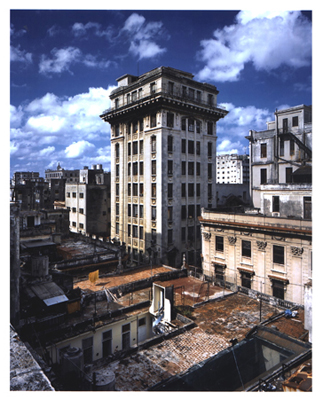|
Stan Douglas “La Inalámbrica” building / Metropolitan building. Havana Vieja, 2004 |
| Photograph | C-Print |
| 101 x 81.3 cm |
 |
The project carried out by Stan Douglas (1960) in Fidel Castro’s Cuba, in the historical period when the island is still governed by the dictator, is an idea that makes use of film, video and photography in a record of the historical construction that has taken place there since the sixties. A political, social and economic history expressed in a journey around the different architectural transformations in the city of Havana, which are a succession of attempts and failures of a modern utopia. Consecutive essays that will materialise in the gradual “readaptations” undergone by landmark buildings in the city, whose uses and meanings have been recycled continuously from the period of the Cuban revolution to the present. A degradation of experience that works alongside the different “updatings” of society itself, in what can be described as a relation of reciprocal estrangement. “La Inalámbrica” Building / Metropolitan Building is a photograph of a building which was originally designed for a telecommunications company but years later was used as the headquarters of the Merchant Navy, and has finally been converted into the offices of an international company. Likewise, and following this urban “recycling” logic, Cine Majestic / Carpentry Shop refers in its title to the transformations in function of a building conceived as a cinema which is now being used as a carpentry shop; an empty, decaying interior covered with wood shavings and rust. What were once banks, churches, convents or even theatres have been deprived of their original meaning and converted into schools, concert halls or shops, in an attempt to reuse – to control – the space; one of the first consequences of the desperate attempt to face up to the wear and tear of history. A crazy architectural transformation where monument and ruin are confused and where, moreover, many contradictions, unresolved projects and even the failure of the utopian aspirations expressed by the 1959 revolution crystallise. As symbolic structures of the deterioration that has taken place in the political system of the territory, the buildings recorded by Douglas may be defined as “palimpsests”, in his own words, as objects whose initial purpose has been erased by the effect of the contents superimposed at different – and in a way unfinished – stages to accommodate the new, urgent demands imposed by the highly unstable, precarious and resistant political context. As in other pieces of his, the object of study seems to be “absent” and is approached precisely by indirect, but in the end effective, forms of representation. In a landscape that has much to do with an exotic, anachronistic postcard willing to be photographed by anyone who comes to the island, Douglas nevertheless distances himself from any possible normalised relation with the nostalgic, stereotyped cliché publicised by the authorities. He avoids the “big subjects” shared by inhabitants and outsiders which are in a way “celebrated” in many of the images exported from the territory. The artist’s neutral, empty gaze, the mechanism of random repetition of specific motifs or the analysis of those architectural containers of unresolved ideological waste bring about an enforced break with any previously established discourse, revealing the drift taken by the Cuban ideological project. A drift that is formalised through the architectural transformation and its readaptation to the different devices of urban organisation – almost an archaeological study of the last decades –, which, through the changes that materialise in the images, highlights the many breaks undergone in the course of history. A story which, on all too many occasions, especially in the political context of Cuba, is one-way and partial, but which breaks up rapidly when confronted by the artist’s series of photographic microstories; small, static narrations which, like the uses and functions of the buildings of Havana, are redefined by different superimposed layers until they make up the complex landscape of the Cuban people. Beatriz Herráez |
![]()

